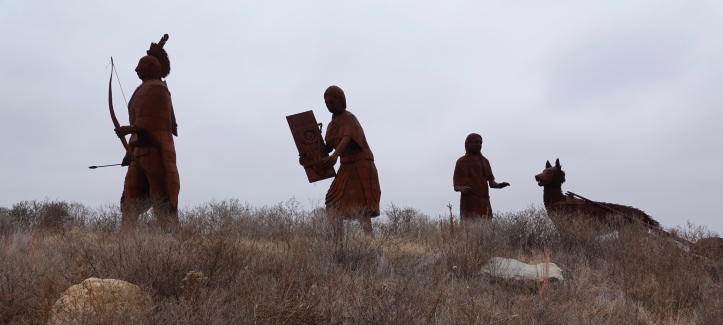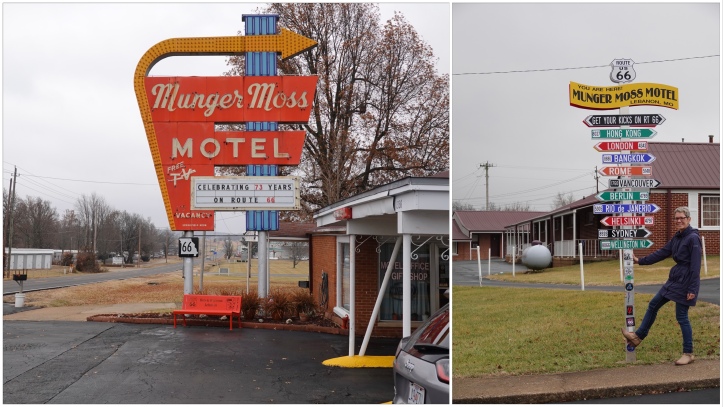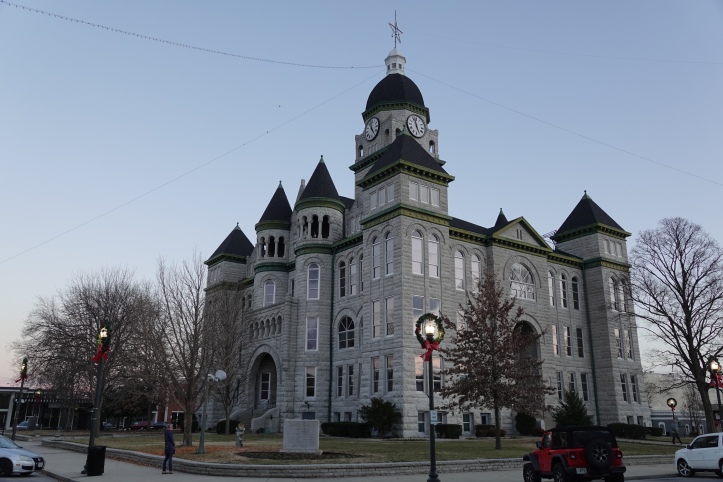St. Louis was the first city on our route that intersected Historic Route 66. Ted and I thought it would make a good starting place to explore that famous route, but (according to information from the Smithsonian) “In 1956, legislation created the Interstate System, and over the course of three decades, five separate interstates bypassed segment after segment of Route 66. Its signature black-and-white shield markers were taken down, and in 1985, Route 66 was officially decommissioned.”

So.
It turns out we are a whole generation too late to drive the original route, but the towns that made their reputations as stops along the way are still there, and doing their best to make up for the lost tourism dollars that speed by on the highways. The interstates may not literally have paved over Route 66, but they certainly did so figuratively. Using notes from a website we found https://www.route66roadtrip.com , we headed out for a day of exploring. We were going to try to make 5 stops of no more than 30 minutes each for a total travel day of 7-1/2 hours, which would get us to our overnight in Joplin with enough time to look around a bit before sunset at 5:30.
Our first stop was Cuba, Missouri. In an effort curiously parallel to one undertaken by the town of Chemainus on Vancouver Island, Cuba decided in the 1990’s to commission a series of huge murals around their small town of just over 3000 people, with a view to luring tourists off the interstate. The murals depict historic events from the civil war through to WWII, as well as 19th century business activities. In a second connection to Canada, two of the murals were painted by a Canadian muralist, Michelle Loughery.

Wandering around town we found a wonderful little museum, where the elegant volunteer shared lots of interesting facts about the exhibits (ranging from civil war era clothing to Osage Indian artifacts to items from the original one room schoolhouse), as well as her personal experiences moving from the big city of Chicago to the “podunk town” that she has come to love.
We also took in the beautiful Catholic church, built by hand out of Missouri stones simply picked up off the ground as fields were cleared.

On the ramp to the highway out of town we stopped at the Osage Trail Monument. Thousands of Osage were re-located to the Oklahoma Territories after the Louisiana Purchase. They were the only tribe to actually buy their lands, choosing property that white settlers did not find suitable. Despite that, when oil was found on those lands years later, making the tribe wealthy in their own right, most of the Osage were murdered to prevent the land being inherited within the tribe, and the land taken by whites. More and more as we travel around and read about the history of North America, we come to a better understanding of why Indigenous peoples are angry.

Having spent more time than expected in Cuba, we did a quick drive-by photo stop in Rolla at the Mule Trading Post. One of the fun facts we learned about Rolla was that it was named after Raleigh, but spelled “phonetically” because the original spelling was just too hard. Given that “Rolla” is not even close to the way we Canadians pronounce “Raleigh”, we both found that story pretty funny.

Our next stop was in Lebanon, where we had a photo op at the iconic Munger Moss Motel (73 years on Route 66!) and ate a terrific lunch at the Elm Street Eatery right on the route before checking out the local Route 66 Museum housed in the library.

From Lebanon we headed to Springfield, the birthplace of Route 66. While the highway itself went from Chicago to Los Angeles, it was in Springfield that it officially got its number designation. In addition to checking out some of the classic architecture like the art deco theatre, we visited the marker commemorating the spot on which “Wild Bill” Hickok stood when he fired the shot that killed Davis Tutt on July 21, 1865. In Lebanon’s “Park Central” we met Rex McGee (and his dog Chumley), who had all kinds of stories to tell about the area. It would be rude not to talk to the local folks when we’re tourists in their town, so our visit to Lebanon was also longer than planned. Joplin before dark was beginning to look unlikely.

We reached Carthage, Missouri in twilight. Carthage was the site of the first major battle of the Civil War, commemorated on a small monument outside the stunning Jasper County Courthouse that is listed on the National Register of Historic Sites. The building is made of high quality limestone (aka “Carthage marble”) in a style called Richardsonian Romanesque. Apparently it is the second most photographed edifice in Missouri, after the Gateway Arch. Ted can now say he took pictures of both!


We pulled into our hotel in Joplin in the dark. Unlike Bonnie and Clyde, who spent several weeks here in 1933, Ted and I will be on the lam tomorrow morning.
Loving it!
LikeLike
What an interesting day you two experienced. You make me want to visit these small towns to discover their charm, if ever in that neighbourhood. Keep writing Rose, keep writing.
LikeLike
There’s definitely something to discover EVERYWHERE! We never cease to be surprised.
LikeLike
What a positively fun day!!!!!!!!
Sent from my iPhone
LikeLike
It was!! And tomorrow will be too!
LikeLike
Love it Rose, always so interesting and informative!
LikeLike
Thanks Marcia! All those years working in schools, I can’t stop looking for things to learn!
LikeLike